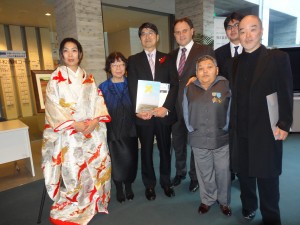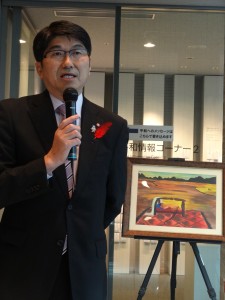TOKYO, Nov. 23 – The ATOM Project, an international campaign against nuclear weapons and nuclear weapons tests launched by President Nursultan Nazarbayev, gave a presentation in Tokyo on Nov. 19 attended by high level attendees, including such dignitaries as Akie Abe, wife of the Japanese Prime Minister.
During the event, held at the Nippon Press Center, ATOM project Honorary Ambassador Karipbek Kuyukov, an artist born without arms as a result of Soviet nuclear tests at Kazakhstan’s Semipalatinsk nuclear test site and who uses his feet and mouth to depict the horror of those tests, invited Abe to Kazakhstan to see firsthand Kazakhstan’s contribution to nuclear disarmament, as well as to strengthen relations between Kazakhstan in Japan.
Members of the Japanese Diet (Parliament), representatives of key state agencies, large companies, the media and heads of the Japan’s well-known anti-nuclear movements and organisations attended the opening ceremony of the event.
Opening the gathering, Ambassador of Kazakhstan to Japan Akylbek Kamaldinov noted the historical significance of Nazarbayev’s decision to close down the Semipalatinsk nuclear test site and Kazakhstan’s continued contribution to strengthening global security, including the efforts of the Atom Project.
The event was organized jointly with the Japanese NGO Earth Identity Project and an initiative by a famous Japanese designer and artist Hiromi Inayoshi called A Picture Book without Pictures, where children are given opportunities to draw their own vision of a nuclear weapons free world.
In his speech, member of the House of Councilors of the National Diet of Japan Kazuyuki Hamada emphasised Nazarbayev’s contributions to the effort to establish a nuclear weapons free world, as well as to establish a Central Asian region nuclear-weapons-free zone.
Abe added that “Karipbek Kuyukov’s paintings inspire people to fight for a world without nuclear weapons. It would be great if art reaches its goal and the world rids itself of nuclear weapons.” Later, commenting about the event and about the meeting with the two artists on her personal Facebook page, Abe posted that “The art will change the world!”
Ambassador-at-large of the Ministry of Foreign Affairs of Kazakhstan Roman Vassilenko noted that the message of the ATOM Project has found support among people from more than 100 countries and that the number of signatories to the project’s online petition has been steadily growing.
ATOM Project presentations and exhibitions of Kuyukov’s art were also held in Hiroshima and Nagasaki on Nov. 20-21, drawing enthusiastic responses and pledges of support.
Mayor of Hiroshima and President of the International Mayors for Peace Movement Kazumi Matsui, Chairman of Hiroshima Peace Culture Foundation and Secretary General of Mayors for Peace Yasuyoshi Komizo, representatives of municipal governments of the prefecture and the city of Hiroshima, the media and regional anti-nuclear weapons associations participated in the Nov. 20 Hiroshima event at the International Conference Centre Hiroshima.
During their visit to Hiroshima, the Kazakhstan delegation together with Komizo and other Japanese colleagues laid flowers at the Cenotaph to commemorate the victims of the atomic bombing. They also visited the World Memorial Museum.
The Kazakhstan delegation also met well-known Hibakusha (atomic bombing survivors) who expressed their full support for the Atom Project.
Later on Nov. 25 in his home city of Karaganda, Kazakhstan, Kuyukov visited local school No. 85, and jointly with Professor Valery Lee, lecturer of the civil disciplines at the Central Kazakh Academy, passed on the message of the Atom Project to school students. Professor Lee reminded young students of the importance of the decree that President Nazarbayev signed back in 1991 to shut down the infamous Semipalatinsk test site and Kuyukov told them about the consequences these tests bear to this day and how they will impact many generations to come.
The next ATOM Project event is scheduled for Dec. 3 in Berlin and Kuyukov is eager to return to Germany where he last visited in 1992.
“Back then [in 1992], I didn’t have the opportunity to show my paintings to the people in Germany. This time, I am well prepared and I am looking forward to this trip to tell the local audience about our mission about the Atom Project, about why it is important today and why we seek their support. I am sure they will pledge their support to us,” Kuyukov said.
On August 29, 2012, when President Nazarbayev launched the ATOM Project at an international conference in Astana, then German Vice Chancellor and Foreign Minister Guido Westervelle immediately pledged his country’s support for the initiative.



